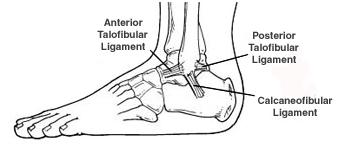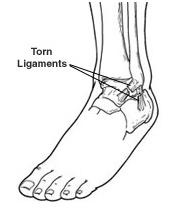Sprains
An ankle sprain is an injury to one or more ligaments in the ankle, usually on the outside of the ankle. Ligaments are bands of tissue – like rubber bands – that connect one bone to another and bind the joints together. In the ankle joint, ligaments provide stability by limiting side-to-side movement.

Some ankle sprains are much worse than others. The severity of an ankle sprain depends on whether the ligament is stretched, partially torn, or completely torn, as well as on the number of ligaments involved.
Causes
Sprained ankles often result from a fall, a sudden twist, or a blow that forces the ankle joint out of its normal position. Ankle sprains commonly occur while participating in sports, wearing inappropriate shoes, or walking or running on an uneven surface.
Sometimes ankle sprains occur because of a person is born with weak ankles. Previous ankle or foot injuries can also weaken the ankle and lead to sprains.
Symptoms Symptoms of ankle sprains may include:
- Pain or soreness
- Swelling
- Bruising
- Difficulty walking
- Stiffness in the joint
These symptoms may vary in intensity, depending on the severity of the sprain. Sometimes pain and swelling are absent in people with previous ankle sprains. Instead, they may simply feel the ankle is wobbly and unsteady when they walk. Even if there is no pain or swelling with a sprained ankle, treatment is crucial. Any ankle sprain – whether it’s your first or your fifth – requires medical attention.
 Diagnosis
Diagnosis
A thorough history of your symptoms and clinical examination is required. X-rays or other advanced imaging studies such as MRI and CT maybe indicated to help determine the severity of the injury.
Non-surgical Treatment
When you have an ankle sprain, rehabilitation is crucial—and it starts the moment your treatment begins. One or more of the following treatment options:
Rest
Stay off the injured ankle. Walking may cause further injury.
Ice
Apply an ice pack to the injured area, placing a thin towel between the ice and the skin. Use ice for 20 minutes and then wait at least 40 minutes before icing again.
Compression
An elastic wrap may be recommended to control swelling.
Elevation
The ankle should be raised slightly above the level of your heart to reduce swelling.
Early physical therapy
Your doctor will start you on a rehabilitation program as soon as possible to promote healing and increase your range of motion. This includes doing prescribed exercises.
Medications
Nonsteroidal anti-inflammatory drugs (NSAIDs), may be recommended to reduce pain and inflammation. In some cases, prescription pain medications are needed to provide adequate relief.
Surgery
In acute ankle sprains surgery is rarely performed. For chronic ankle sprains and patients with history of ankle instability surgery is performed more commonly. Surgery often involves repairing the damaged ligament or ligaments. After surgery, rehabilitation is extremely important.
Chronic Ankle Sprains
The ankle joint is located at the junction of the leg and the foot. It is made up of three bones: the tibia, the fibula and the talus. The ankle joint allows the foot to dorsiflex (point the foot up) and plantarflex (point the foot down).
Ligaments (strong fibrous bands of tissue that connect two bones) are located on each side of the ankle joint to create stability in the joint. Tendons (strong fibrous structures that connect muscle to bone) are located throughout the foot to allow for motion in the other parts of the foot such as the movement of the toes.
Cartilage is the specialized joint tissue that covers bones and allows the bones to move in relationship to each other with minimal friction. Loss of the cartilage can decrease joint function and produce pain, stiffness, swelling and warmth.
Arthritis is a joint condition of damaged cartilage and/or bone which causes the bones to grind on each other with movement, thus causing pain and inflammation. Ankle arthritis is the progressive loss of the smooth gliding surface that lines the ends of the bones that form the ankle. This produces pain, stiffness, swelling and warmth at the joint. These detrimental effects lead to reduced comfort and endurance for standing and walking activities.
Your foot and ankle specialist may recommend rest or medication for pain relief. Physical therapy may also be prescribed in the early stages of ankle arthritis. You should discuss the best option with your surgeon.
An ankle replacement may be needed for those patients with chronic ankle arthritis causing pain that conservative measures such as rest, physical therapy, bracing or medications were unable to correct. Ankle replacement involves replacing the damaged joint with synthetic components.


